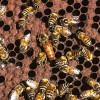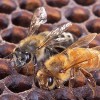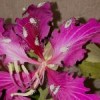 The general public can take several steps to avoid encountering honey bee swarms or colonies. The first and most important step is for citizens to educate themselves and their families about the AHB. This 3-page fact sheet provides links to valuable resources, definitions of key terms, and touches on general precautions and bee-proofing. Written by M. K. O’Malley, J. D. Ellis and A. S. Neal, and published by the UF Department of Entomology and Nematology, October 2014. (Photo: Scott Bauer, USDA/ARS)
The general public can take several steps to avoid encountering honey bee swarms or colonies. The first and most important step is for citizens to educate themselves and their families about the AHB. This 3-page fact sheet provides links to valuable resources, definitions of key terms, and touches on general precautions and bee-proofing. Written by M. K. O’Malley, J. D. Ellis and A. S. Neal, and published by the UF Department of Entomology and Nematology, October 2014. (Photo: Scott Bauer, USDA/ARS)
http://edis.ifas.ufl.edu/in739
Tag: A. S. Neal
Frequently Asked Questions about the Africanized Honey Bee in Florida
 The African honey bee, Apis mellifera scutellata, was introduced into South America from the central and southern part of Africa in 1957. Since its introduction into South America, the African bee has migrated into the southwestern United States and Florida. Apis mellifera scutellata is the African bee subspecies referred to in this 3-page fact sheet, which answers commonly asked questions about these bees and their behavior. Written by M. K. O’Malley, J. D. Ellis and A. S. Neal, and published by the UF Department of Entomology and Nematology, November 2014.
The African honey bee, Apis mellifera scutellata, was introduced into South America from the central and southern part of Africa in 1957. Since its introduction into South America, the African bee has migrated into the southwestern United States and Florida. Apis mellifera scutellata is the African bee subspecies referred to in this 3-page fact sheet, which answers commonly asked questions about these bees and their behavior. Written by M. K. O’Malley, J. D. Ellis and A. S. Neal, and published by the UF Department of Entomology and Nematology, November 2014.
http://edis.ifas.ufl.edu/in738
Integrated Pest Management for Mosquito Reduction around Homes and Neighborhoods
 This 40-page publication describes how homeowners can use an integrated pest management (IPM) program to help decrease pesticide use, reduce the risk of contracting mosquito-borne diseases, and ease the financial burden on local governments responsible for area-wide control. Modern mosquito control emphasizes source reduction to eliminate areas where mosquitoes thrive; surveillance to determine whether pesticide applications are necessary; screening; sanitation; and other techniques described in this document. The methods recommended in this publication are particularly effective in reducing mosquitoes that transmit diseases. Homeowners who take responsibility for identifying and eliminating sources of mosquito production around their homes and neighborhoods will improve health and quality of life for all Florida residents. Written by C. R. Connelly, E. Bolles, D. Culbert, J. DeValerio, M. Donahoe, K. Gabel, R. Jordi, J. McLaughlin, A. S. Neal, S. Scalera, E. Toro, and J. Walter, and published by the UF Department of Entomology and Nematology, September 2014.
This 40-page publication describes how homeowners can use an integrated pest management (IPM) program to help decrease pesticide use, reduce the risk of contracting mosquito-borne diseases, and ease the financial burden on local governments responsible for area-wide control. Modern mosquito control emphasizes source reduction to eliminate areas where mosquitoes thrive; surveillance to determine whether pesticide applications are necessary; screening; sanitation; and other techniques described in this document. The methods recommended in this publication are particularly effective in reducing mosquitoes that transmit diseases. Homeowners who take responsibility for identifying and eliminating sources of mosquito production around their homes and neighborhoods will improve health and quality of life for all Florida residents. Written by C. R. Connelly, E. Bolles, D. Culbert, J. DeValerio, M. Donahoe, K. Gabel, R. Jordi, J. McLaughlin, A. S. Neal, S. Scalera, E. Toro, and J. Walter, and published by the UF Department of Entomology and Nematology, September 2014.
http://edis.ifas.ufl.edu/in1045
Sri Lankan weevil Myllocerus undecimpustulatus undatus Marshall
 Myllocerus undecimpustulatus undatus Marshall, the Sri Lankan weevil, is a plant pest with a wide range of hosts. This weevil spread from Sri Lanka into India and then Pakistan where many subspecies of Myllocerus undecimpustulatus Faust are considered pests of more than 20 crops. In the United States, the Sri Lankan weevil was first identified on Citrus sp. in Pompano Beach a city in Broward County Florida. Three specimens were identified by Dr. Charles W. O’Brien, first as Myllocerus undecimpustulatus, a species native to southern India, and then again as Myllocerus undatus Marshall native to Sri Lanka, finally as Myllocerus undecimpustulatus undatus Marshall to show its status as a subspecies. This 4-page fact sheet was written by Anita Neal, and published by the UF Department of Entomology and Nematology, November 2013.
Myllocerus undecimpustulatus undatus Marshall, the Sri Lankan weevil, is a plant pest with a wide range of hosts. This weevil spread from Sri Lanka into India and then Pakistan where many subspecies of Myllocerus undecimpustulatus Faust are considered pests of more than 20 crops. In the United States, the Sri Lankan weevil was first identified on Citrus sp. in Pompano Beach a city in Broward County Florida. Three specimens were identified by Dr. Charles W. O’Brien, first as Myllocerus undecimpustulatus, a species native to southern India, and then again as Myllocerus undatus Marshall native to Sri Lanka, finally as Myllocerus undecimpustulatus undatus Marshall to show its status as a subspecies. This 4-page fact sheet was written by Anita Neal, and published by the UF Department of Entomology and Nematology, November 2013.
http://edis.ifas.ufl.edu/in1016
ENY141S/IN864 Cómo Lidiar con Abejas Africanas: Una Guía Práctica
ENY141S, a 4-page fact sheet by M. K. O’Malley, J. D. Ellis, Pablo Herrera and A. S. Neal, is the Spanish language version of ENY-141/IN739 What to do about African Honey Bees: A Consumer Guide. It provides information about Africanized honey bees (AHB), which have been labeled ”killer” bees, steps people can take to avoid negative interactions, how to handle stings, and bee-proofing basics. Published by the UF Department of Entomology and Nematology, August 2010.
http://edis.ifas.ufl.edu/in864
ENY140S/IN862 Preguntas Frecuentes Acerca de la Abeja Melífera Africanizada en Florida
ENY-140S, a 3-page fact sheet by M. K. O’Malley, J. D. Ellis, P. Herrera and A. S. Neal, is the Spanish language version of ENY140/IN738 Frequently Asked Questions about the Africanized Honey Bee in Florida. It provides information about Africanized honey bees (AHB) in a question-and-answer format. Published by the UF Department of Entomology and Nematology, August 2010.
http://edis.ufl.edu/in862